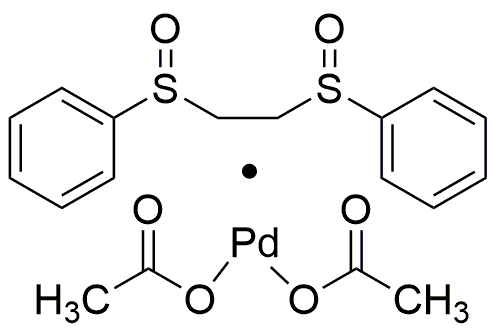1,2-Bis(phenylsulfinyl)ethane Palladium(II) diacetate is widely utilized in research focused on:
- Catalysis: This compound serves as an effective catalyst in various organic reactions, particularly in cross-coupling reactions, which are essential for synthesizing complex organic molecules in pharmaceuticals and agrochemicals.
- Organic Synthesis: It plays a crucial role in the synthesis of sulfinyl-containing compounds, which are valuable in the development of new drugs and materials, enhancing the efficiency of chemical processes.
- Material Science: Utilized in the fabrication of advanced materials, this compound contributes to the development of polymers and nanomaterials with unique properties, aiding industries like electronics and coatings.
- Research in Medicinal Chemistry: It is instrumental in the design and synthesis of novel therapeutic agents, particularly those targeting specific biological pathways, thus facilitating drug discovery efforts.
- Environmental Chemistry: The compound is explored for its potential in catalyzing reactions that lead to the degradation of pollutants, contributing to greener chemistry practices and environmental sustainability.
General Information
Properties
Safety and Regulations
Applications
1,2-Bis(phenylsulfinyl)ethane Palladium(II) diacetate is widely utilized in research focused on:
- Catalysis: This compound serves as an effective catalyst in various organic reactions, particularly in cross-coupling reactions, which are essential for synthesizing complex organic molecules in pharmaceuticals and agrochemicals.
- Organic Synthesis: It plays a crucial role in the synthesis of sulfinyl-containing compounds, which are valuable in the development of new drugs and materials, enhancing the efficiency of chemical processes.
- Material Science: Utilized in the fabrication of advanced materials, this compound contributes to the development of polymers and nanomaterials with unique properties, aiding industries like electronics and coatings.
- Research in Medicinal Chemistry: It is instrumental in the design and synthesis of novel therapeutic agents, particularly those targeting specific biological pathways, thus facilitating drug discovery efforts.
- Environmental Chemistry: The compound is explored for its potential in catalyzing reactions that lead to the degradation of pollutants, contributing to greener chemistry practices and environmental sustainability.
Documents
Safety Data Sheets (SDS)
The SDS provides comprehensive safety information on handling, storage, and disposal of the product.
Product Specification (PS)
The PS provides a comprehensive breakdown of the product’s properties, including chemical composition, physical state, purity, and storage requirements. It also details acceptable quality ranges and the product's intended applications.
Certificates of Analysis (COA)
Search for Certificates of Analysis (COA) by entering the products Lot Number. Lot and Batch Numbers can be found on a product’s label following the words ‘Lot’ or ‘Batch’.
*Catalog Number
*Lot Number
Certificates Of Origin (COO)
This COO confirms the country where the product was manufactured, and also details the materials and components used in it and whether it is derived from natural, synthetic, or other specific sources. This certificate may be required for customs, trade, and regulatory compliance.
*Catalog Number
*Lot Number
Safety Data Sheets (SDS)
The SDS provides comprehensive safety information on handling, storage, and disposal of the product.
DownloadProduct Specification (PS)
The PS provides a comprehensive breakdown of the product’s properties, including chemical composition, physical state, purity, and storage requirements. It also details acceptable quality ranges and the product's intended applications.
DownloadCertificates of Analysis (COA)
Search for Certificates of Analysis (COA) by entering the products Lot Number. Lot and Batch Numbers can be found on a product’s label following the words ‘Lot’ or ‘Batch’.
*Catalog Number
*Lot Number
Certificates Of Origin (COO)
This COO confirms the country where the product was manufactured, and also details the materials and components used in it and whether it is derived from natural, synthetic, or other specific sources. This certificate may be required for customs, trade, and regulatory compliance.


